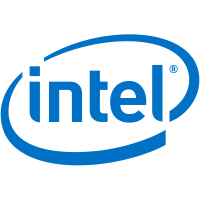Intel UHD Graphics 750 vs NVIDIA GeForce GTX 480
Análise comparativa de placas de vídeo Intel UHD Graphics 750 e NVIDIA GeForce GTX 480 para todas as características conhecidas nas seguintes categorias: Essenciais, Informações técnicas, Saídas de vídeo e portas, Suporte API, Compatibilidade, dimensões e requisitos, Memória, Tecnologias. Análise de desempenho de placas de vídeo de referência: PassMark - G3D Mark, PassMark - G2D Mark, Geekbench - OpenCL, CompuBench 1.5 Desktop - Face Detection (mPixels/s), CompuBench 1.5 Desktop - Ocean Surface Simulation (Frames/s), CompuBench 1.5 Desktop - T-Rex (Frames/s), CompuBench 1.5 Desktop - Video Composition (Frames/s), GFXBench 4.0 - Car Chase Offscreen (Frames), GFXBench 4.0 - Manhattan (Frames), GFXBench 4.0 - T-Rex (Frames), GFXBench 4.0 - Car Chase Offscreen (Fps), GFXBench 4.0 - Manhattan (Fps), GFXBench 4.0 - T-Rex (Fps), 3DMark Fire Strike - Graphics Score, CompuBench 1.5 Desktop - Bitcoin Mining (mHash/s).
Diferenças
Razões para considerar o Intel UHD Graphics 750
- Placa de vídeo é mais recente: data de lançamento 15 ano(s) e 0 mês(es) depois
- 495.2x mais taxa de preenchimento de textura: 20.80 GTexel/s vs 42 billion / sec
- Um processo de fabricação mais recente permite uma placa de vídeo mais poderosa, porém mais refrigerada: 14 nm vs 40 nm
- 16.7x menor consumo de energia: 15 Watt vs 250 Watt
- Cerca de 2% melhor desempenho em CompuBench 1.5 Desktop - Face Detection (mPixels/s): 35.179 vs 34.483
- 3.3x melhor desempenho em GFXBench 4.0 - T-Rex (Frames): 11068 vs 3320
- 3.3x melhor desempenho em GFXBench 4.0 - T-Rex (Fps): 11068 vs 3320
| Especificações | |
| Data de lançamento | 2021 vs 26 March 2010 |
| Taxa de preenchimento de textura | 20.80 GTexel/s vs 42 billion / sec |
| Tecnologia de processo de fabricação | 14 nm vs 40 nm |
| Potência de Design Térmico (TDP) | 15 Watt vs 250 Watt |
| Benchmarks | |
| CompuBench 1.5 Desktop - Face Detection (mPixels/s) | 35.179 vs 34.483 |
| GFXBench 4.0 - T-Rex (Frames) | 11068 vs 3320 |
| GFXBench 4.0 - T-Rex (Fps) | 11068 vs 3320 |
Razões para considerar o NVIDIA GeForce GTX 480
- 2.3x mais velocidade do clock do núcleo: 700 MHz vs 300 MHz
- Cerca de 88% mais pipelines: 480 vs 256
- 2.4x melhor desempenho em PassMark - G3D Mark: 4121 vs 1726
- Cerca de 19% melhor desempenho em PassMark - G2D Mark: 430 vs 362
- 2x melhor desempenho em Geekbench - OpenCL: 13144 vs 6460
- Cerca de 30% melhor desempenho em CompuBench 1.5 Desktop - Ocean Surface Simulation (Frames/s): 706.104 vs 543.594
- 2.1x melhor desempenho em CompuBench 1.5 Desktop - T-Rex (Frames/s): 4.245 vs 1.995
- Cerca de 4% melhor desempenho em CompuBench 1.5 Desktop - Video Composition (Frames/s): 30.405 vs 29.322
- Cerca de 76% melhor desempenho em GFXBench 4.0 - Car Chase Offscreen (Frames): 5110 vs 2899
- Cerca de 14% melhor desempenho em GFXBench 4.0 - Manhattan (Frames): 3658 vs 3219
- Cerca de 76% melhor desempenho em GFXBench 4.0 - Car Chase Offscreen (Fps): 5110 vs 2899
- Cerca de 14% melhor desempenho em GFXBench 4.0 - Manhattan (Fps): 3658 vs 3219
| Especificações | |
| Velocidade do clock do núcleo | 700 MHz vs 300 MHz |
| Pipelines | 480 vs 256 |
| Benchmarks | |
| PassMark - G3D Mark | 4121 vs 1726 |
| PassMark - G2D Mark | 430 vs 362 |
| Geekbench - OpenCL | 13144 vs 6460 |
| CompuBench 1.5 Desktop - Ocean Surface Simulation (Frames/s) | 706.104 vs 543.594 |
| CompuBench 1.5 Desktop - T-Rex (Frames/s) | 4.245 vs 1.995 |
| CompuBench 1.5 Desktop - Video Composition (Frames/s) | 30.405 vs 29.322 |
| GFXBench 4.0 - Car Chase Offscreen (Frames) | 5110 vs 2899 |
| GFXBench 4.0 - Manhattan (Frames) | 3658 vs 3219 |
| GFXBench 4.0 - Car Chase Offscreen (Fps) | 5110 vs 2899 |
| GFXBench 4.0 - Manhattan (Fps) | 3658 vs 3219 |
Comparar benchmarks
GPU 1: Intel UHD Graphics 750
GPU 2: NVIDIA GeForce GTX 480
| PassMark - G3D Mark |
|
|
||||
| PassMark - G2D Mark |
|
|
||||
| Geekbench - OpenCL |
|
|
||||
| CompuBench 1.5 Desktop - Face Detection (mPixels/s) |
|
|
||||
| CompuBench 1.5 Desktop - Ocean Surface Simulation (Frames/s) |
|
|
||||
| CompuBench 1.5 Desktop - T-Rex (Frames/s) |
|
|
||||
| CompuBench 1.5 Desktop - Video Composition (Frames/s) |
|
|
||||
| GFXBench 4.0 - Car Chase Offscreen (Frames) |
|
|
||||
| GFXBench 4.0 - Manhattan (Frames) |
|
|
||||
| GFXBench 4.0 - T-Rex (Frames) |
|
|
||||
| GFXBench 4.0 - Car Chase Offscreen (Fps) |
|
|
||||
| GFXBench 4.0 - Manhattan (Fps) |
|
|
||||
| GFXBench 4.0 - T-Rex (Fps) |
|
|
| Nome | Intel UHD Graphics 750 | NVIDIA GeForce GTX 480 |
|---|---|---|
| PassMark - G3D Mark | 1726 | 4121 |
| PassMark - G2D Mark | 362 | 430 |
| Geekbench - OpenCL | 6460 | 13144 |
| CompuBench 1.5 Desktop - Face Detection (mPixels/s) | 35.179 | 34.483 |
| CompuBench 1.5 Desktop - Ocean Surface Simulation (Frames/s) | 543.594 | 706.104 |
| CompuBench 1.5 Desktop - T-Rex (Frames/s) | 1.995 | 4.245 |
| CompuBench 1.5 Desktop - Video Composition (Frames/s) | 29.322 | 30.405 |
| GFXBench 4.0 - Car Chase Offscreen (Frames) | 2899 | 5110 |
| GFXBench 4.0 - Manhattan (Frames) | 3219 | 3658 |
| GFXBench 4.0 - T-Rex (Frames) | 11068 | 3320 |
| GFXBench 4.0 - Car Chase Offscreen (Fps) | 2899 | 5110 |
| GFXBench 4.0 - Manhattan (Fps) | 3219 | 3658 |
| GFXBench 4.0 - T-Rex (Fps) | 11068 | 3320 |
| 3DMark Fire Strike - Graphics Score | 641 | 0 |
| CompuBench 1.5 Desktop - Bitcoin Mining (mHash/s) | 106.875 |
Comparar especificações
| Intel UHD Graphics 750 | NVIDIA GeForce GTX 480 | |
|---|---|---|
Essenciais |
||
| Arquitetura | Generation 12.1 | Fermi |
| Nome de código | Rocket Lake GT1 | GF100 |
| Data de lançamento | 2021 | 26 March 2010 |
| Posicionar na avaliação de desempenho | 759 | 757 |
| Tipo | Desktop | Desktop |
| Preço de Lançamento (MSRP) | $499 | |
| Preço agora | $71.99 | |
| Custo-benefício (0-100) | 61.35 | |
Informações técnicas |
||
| Aumentar a velocidade do clock | 1300 MHz | |
| Unidades do Compute | 32 | |
| Velocidade do clock do núcleo | 300 MHz | 700 MHz |
| Tecnologia de processo de fabricação | 14 nm | 40 nm |
| Peak Double Precision (FP64) Performance | 166.4 GFLOPS (1:4) | |
| Peak Half Precision (FP16) Performance | 1331 GFLOPS (2:1) | |
| Peak Single Precision (FP32) Performance | 665.6 GFLOPS | |
| Pipelines | 256 | 480 |
| Pixel fill rate | 10.40 GPixel/s | |
| Taxa de preenchimento de textura | 20.80 GTexel/s | 42 billion / sec |
| Potência de Design Térmico (TDP) | 15 Watt | 250 Watt |
| Núcleos CUDA | 480 | |
| Desempenho de ponto flutuante | 1,345.0 gflops | |
| Temperatura máxima da GPU | 105 °C | |
| Contagem de transistores | 3,100 million | |
Saídas de vídeo e portas |
||
| Conectores de exibição | No outputs | 2x DVI, 1x mini-HDMI, Two Dual Link DVI, Mini HDMI |
| Entrada de áudio para HDMI | Internal | |
| HDCP | ||
| HDMI | ||
| Resolução máxima de VGA | 2048x1536 | |
| Suporte a múltiplos monitores | ||
Suporte API |
||
| DirectX | 12.0 (12_1) | 12.0 (11_0) |
| OpenCL | 3.0 | |
| OpenGL | 4.6 | 4.2 |
| Shader Model | 6.4 | |
| Vulkan | ||
Compatibilidade, dimensões e requisitos |
||
| Barramento de suporte | 16x PCI-E 2.0 | |
| Altura | 4.376" (111 mm) (11.1 cm) | |
| Interface | PCIe 2.0 x16 | |
| Comprimento | 10.5" (267 mm) (26.7 cm) | |
| Opções de SLI | 2-way, 3-way | |
| Conectores de alimentação suplementares | 6-pin & 8-pin | |
Memória |
||
| Quantidade máxima de RAM | 1536 MB | |
| Largura de banda de memória | 177.4 GB / s | |
| Largura do barramento de memória | 384 Bit | |
| Velocidade do clock da memória | 1848 MHz (3696 data rate) | |
| Tipo de memória | GDDR5 | |
| Memória compartilhada | 0 | |
Tecnologias |
||
| 3D Vision | ||
| CUDA | ||
| DirectX 11 | DirectX 11 | |
| SLI | ||










